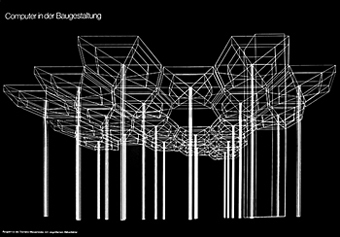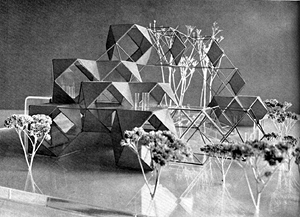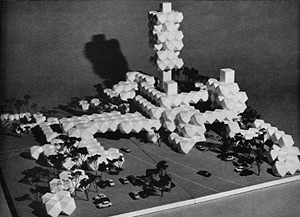Kubo-Oktaeder (Cuboctahedron)
nees-rase: architecture meets early computer art
When architect Ludwig Rase and computer art pioneer Georg Nees teamed up, their work turned out to be a milestone in computer aided architectural design.
Apart from designing system building structures, they also created one of the earliest and best known computer graphics with an architectural reference: The »Kubo-Oktaeder«, also known as Cubo-Octaeder or Cuboctahedron.
origins: the computer in the architectural design process
By the end of the 1960s the United States had already started creating early applications of computer programs in the architectural design process.
Among the first examples are some of
Richard Buckminster Fuller's geodesic domes, for which architect Ronald »Ron«
Resch calculated the bar structures in different variations by using a computer program.
These geodesic domes, developed as system buildings, were widely used as exhibition stand constructions.
In Germany, the first built architectural construction based on plans developed by the use of a computer, was the Siemens pavilion located at the Hannover Messe of 1970.
The pavilion was a modular roof structure supported by columns, which was also a system building designed by architect Ludwig Rase. Georg Nees created the program in
ALGOL for a Siemens System 4004.

|

|
The Siemens pavilion at the Hannover Messe of 1970 presented on a poster: The Computer in Construction Design.
|
Georg Vrachliotis describes the design process in his book »Geregelte Verh ltnisse«:
»Nees did in this case not only act as an artist, but also in the role of the technical expert and architectural assistant in the sense of Gropius, writing a computer program, which was able to calculate the optimum size of the basic module for the roof structure. The clou of the program was, that Nees managed to generate different versions of the basic module and to calculate a three-dimensional model of the pavilion's structure for each of the different sized module versions.
Indeed, Rase had determined the overall concept, but the design of the different versions was no longer in his hands.«*
The computer turned out to be a major contributor to the design process. Siemens pavilion of 1970 became a medium of advertisement where the company used the slogan: »Siemens 4004 designed exhibition stand«.
This early use of computers to solve architectural design problems was setting a trend for CAD in architectural offices and design. This system building shows the computer's influence on the final construction design.
Ludwig Rase stated three major benefits of integrating a computer in the design process: it enabled to work on a higher level of structural systematics, helped to deal with structural complexity and was able to produce a decidedly higher number of design variations to choose from.
*Quote from the book »Geregelte Verh ltnisse: Architektur und technisches Denken in der Epoche der Kybernetik« by Georg Vrachliotis (currently only available in German).

nees-rase: computer art meets architecture
Besides the Siemens pavilion at the Hannover Messe 1970, Rase and Nees developed another exhibition stand for the German Industries Fair in São Paulo, 1971. This pyramid-shaped pavilion was presented ahead of its construction in an innovative film using computer graphics to pre-view the soon to be built exhibition stand.
In 1970/71 Ludwig Rase, working at the Design-Institute Munich, further developed a modular structure for housing and city planning. The basic module was a »Kubo-Oktaeder«, a cuboctahedron. See Wikipedia: Cuboctahedron.
Georg Nees also wrote programs for this more utopian project. Some elements of the designed structure were presented in the International Gardening Exhibition in Hamburg 1973 (IGA 1973), as a temporary pavilion.

Scale model of the cuboctahedron housing structure.*
|

|

Ludwig Rase s modular city structure.*
|
In this case, the computer was also used for layout design. Ludwig Rase describes the use of the computer to design the overall structure:
»The challenge now is to assemble the housing elements in the most optimized way regarding the space-allocation plan. The solution can be calculated by using a computer, taking into consideration that each module can have different functions (...). The programming of the individual spatial functions is based on an »atomic model«. Each spatial unit is regarded as an atom, which can have different functions; according to given valencies, these housing units can be connected to groups (...). The spatial perspective necessary for such planning, exceeds by far the spatial sense of the designer. By using a data processing system the accurate solutions can be visualized and optimized spatial groups can be formed.«*
In 1972 Ludwig Rase (design) and Georg Nees (program) won an art competition for a sculpture at the Werner-von-Siemens-Gymnasium in Regensburg, Germany. The sculpture »Kubo-Oktaeder«, a chromed MERO-structure of cuboctahedrons, can be seen in the theatre yard of the school.
*Quote and images from Ludwig Rase: Two- and Three-Dimensional Computer Design, in NOVUM Gebrauchsgraphik August 8/1972

the computer graphic: kubo-oktaeder

|

|
Ludwig Rase, Georg Nees: Kubo-Oktaeder
screen print for the exhibition »computer art« at Kunsthalle Hamburg 1972/73
screen print after plotter drawing, 1972
Idea: Georg Nees, Ludwig Rase
Program: Georg Nees
Generated 1968-1970**, likely in Munich, Germany.
Programmed in ALGOL for
Siemens 4004 (acc. to print) and
drawn on a ZUSE-Graphomat Z64.
|
This screen print showing the computer graphic »Kubo-Oktaeder« was printed in 1972 for the exhibition »computer art. nees rase.«,
which took place at the Kunsthalle in Hamburg, Germany between 29.9.1972 and 14.1.1973.
The motif was an art project by Rase and Nees depicting the world of Humanities and Natural Sciences in harmony***.
It is composed of two elements: a human figure in two elevations and an architectural structure.
The human figure is an artistic quote, it is a proportion study by Albrecht Dürer and represents the Humanities.
The figure is shown frontal and on the side, displaying the auxiliary lines used in constructing the drawing.
The two elevations resemble the scale figures used in many architectural illustrations, positioned besides a structure formed by aligned and overlying cuboctahedrons.
The drawing of the cuboctahedron structure used in this computer graphic stands for the Natural Sciences.
It is a rotated version of a computer generated isometric drawing of Ludwig Rase s housing structure.
**The catalogue »Ex Machina« gives the years 1968-1970, and quotes Georg Nees, by giving the generative credits to the Siemens 2002 computer.
***Ludwig Rase: Computerunterstützter Entwurf von Raumstrukturen. In: Apparative Kunst, edited by Herbert W. Franke and Gottfried Jäger, 1973

artists profiles
Ludwig Rase (1925-2009)
Born 1925 in Nuremberg, Germany, studied architecture 1945-51 at TU Munich, Germany, worked with Georg Nees from 1969 to 1973, participated at Biennale in Venice 1970, lived and worked in Munich, Germany.
Georg Nees (1926-2016)
Born 1926 in Nuremberg, Germany, studied mathematics, physics and philosophy in Erlangen and in Stuttgart, Germany. As a student with Max Bense
first exhibition of computer art in Germany. Ph.D. in 1969 in »Generative Computergraphik«.
Worked with Ludwig Rase from 1969 to 1973. Nees is a pioneer of computer art, his works were shown in multiple exhibitions.
The computer graphic »Kubo-Oktaeder« has been on display in many exhibitions, for example:
»computer art. nees rase.«, Hamburger Kunsthalle, Hamburg, Germany, 1972/73
»tendencies 5« Section: Computer Visual Research, MSU Zagreb, Croatia (formerly Yugoslavia), 1973
»I Am Still Alive«, PM gallery, Mi2 Institute, u.a., Zagreb, Croatia, 2000
»Ex Machina Fr he Computergrafik bis 1979« Kunsthalle Bremen, Germany, 2007
»bit international. [Nove] tendencije. Computer und visuelle Forschung Zagreb 1961-1973« Neue Galerie Graz am Landesmuseum Joanneum, Austria, 2007
»bit international« ZKM Karlsruhe, Germany, 2008-2009
»Kubo-Oktaeder« e.g. publicized in:
Computer-Grafik Galerie. Herbert W. Franke (1984)
Ex Machina Fr he Computergrafik bis 1979. Hrsg. Wulf Herzogenrath und Barbara Nierhoff-Wielk (2007)
bit international. [Nove] tendencije. Computer und visuelle Forschung Zagreb 1961-1973. Hrsg. Neue Galerie Graz (2007)
bit international. [Nove] tendencije. Computer und visuelle Forschung Zagreb 1961-1973. Hrsg. Peter Weibel und Margit Rosen (ZKM, 2008)
A Little-Known Story about a Movement, a Magazine and the Computer s Arrival in Art: New Tendencies and Bit International. Hrsg. Margit Rosen (2011)
Books on architecture and early computer art (mostly in German):
Computergraphik – Computerkunst. Herbert W. Franke (1985)
Ludwig Rase: Two- and Three-Dimensional Computer Design. In: NOVUM Gebrauchsgraphik August 8/1972
Geregelte Verh ltnisse: Architektur und technisches Denken in der Epoche der Kybernetik. Georg Vrachliotis (2012)
Ingeborg M. Rocker: Berechneter Zufall. Max Benses Informationsästhetik. In: Kulturtechnik Entwerfen Hrsg.: Gethmann und Hanser (2009)
The Architecture Machine: The Role of Computers in Architecture. Editors: Teresa Fankhänel, Andres Lepik (2020)

|
|





